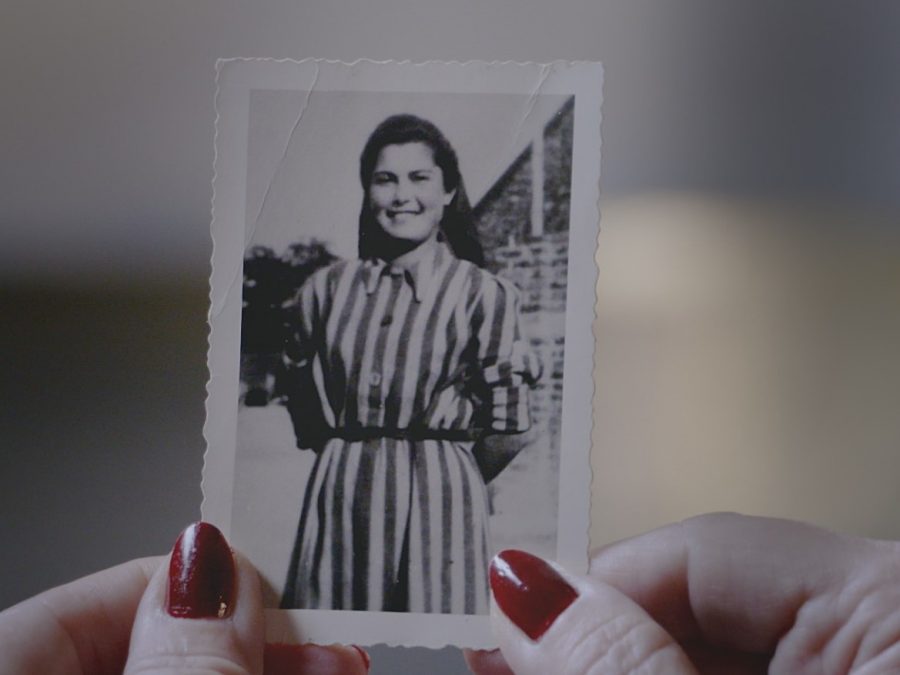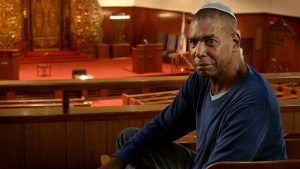Jewish Film Festival: Documentary tells strange tale of survival in Auschwitz
Published June 4, 2021
“Love It Was Not” is a Shoah survivor’s story about a young woman who was at Auschwitz, but it is also a strange tale about obsession, love and survival. The documentary opens with an old photo. We see a picture of a healthy, pretty, young woman smiling, but something is off. The striped dress she is wearing is her prisoner uniform, even though she has it belted, and the photo was taken at Auschwitz. As one of the interviewees says in this intriguing documentary, “Who smiles in Auschwitz?” The film explores the mysteries behind the smiling girl, in an astonishing story.
“Love It Was Not” is one of the films featured in this year’s virtual St. Louis Jewish Film Festival, and the screening is accompanied by a discussion with the film’s Israeli director, Maya Sarfaty, who is interviewed by Warren Rosenblum, professor of history, politics and international relations at Webster University. The Israeli/Austrian documentary is in Hebrew, English and German, with English subtitles.
Helena Citron was the daughter of a cantor, who has a beautiful singing voice and has ambitions to be an actress. Her family’s prosperous, happy life in Czechoslovakia is disrupted by a letter, sending them all off to concentration camps. Helena is among the first thousand women to arrive at Auschwitz while it is still being constructed.
Shortly after she arrives, SS guards come to her barracks, looking for dancers or singers to entertain at a party for the commandant’s birthday. “The Germans loved entertainers,” one of the other survivors in the film notes, with a wry half-smile. One of the women says that the new girl, Helena, sings well, and so off she goes. At the party, she sings in German, a song called “Love It Was Not,” about a disappointed lover. One of the Nazis, a 20-year-old SS officer named Franz Wunsch, is immediately smitten. Afterwards, he politely asks her to sing the song again, and she is so surprised the hear the word “please,” a word she has heard from no other Nazi.
Still, he’s a Nazi and Helena reacted as one expects. “I hated him at first, and avoided looking at him,” she says in interview footage. But he stays polite and respectful, sends her sheets and a pillowcase, and keeps doing nice things, while telling her he is looking for a way for her to escape. It dawns on her she can use this love-sick German to help her friends, and starts asking him to help them, to which he responds, “anything for you.”
The photo that “Love It Was Not” opens with was taken by Wunsch, that SS officer. With a skillfully crafted narrative and an inventive visual style, this well-researched documentary features interviews with a surprising number of Shoah survivors who were with Helena in Auschwitz, as well as Helena herself. Helena looks pretty in the picture, but interview footage shows a still-striking looking woman with large, piercing dark eyes, even at her advanced age. The director expanded on her award-winning short documentary for this film but also footage of interviews of people in this story who died before Sarfaty even started her documentary, including Helena.
All the interviewees agreed that it was true love for the SS officer, but Helena’s feelings are less clear. The documentary offers interviews with numerous survivors who knew her in the camp, some friends who take a sympathetic view of her choices – what choice does a prisoner really have? – while others who resented, even despised, her for her association with a Nazi.
It is a complicated picture, but director Sarfaty handles the story with style, letting the people who were there speak their different views and recount their memories. The film uses that one photo of Helena, along with others, as cut-outs to recreate scenes in the camp and elsewhere to illustrate events. Curiously, according to his daughter, after the war the former Nazi guard would also use copies of that photo as cut-outs, sometimes along with photos of himself, to create happy fantasy scenes of Helena in various locations.
By chance, Helena is assigned to work in the room where prisoners sort out the contents of suitcases of the new arrivals. It was considered the best assignment in the camp because sometimes there was food in the suitcases, which they would eat, and also there were warm clothes to wear under their thin uniforms. That assignment likely had something to do with why so many of them survived, but Helena and her love-struck German also played a role. The guard was no Schindler — he was as brutal as any Nazi to the male prisoners and not always kind to women not close to Helena — but he was kind and helpful to her and her friends. More than once he did risky things to save her or those close to her, fully aware of the risk, that he could be shot if discovered, as noted in interview footage. After the war, the tables turned and he called on her to help him, when he went on trial for war crimes in Austria, confronting her with a fresh dilemma.
As the last survivors of the Shoah leave us, it is essential to capture their stories, no matter how strange, complex, morally murky or unexpected. “Love It Was Not” is one of the most usual of those stories but this well-made, balanced and insightful documentary gives a look into the complexity of the human heart.
‘Love It Was Not’
Part of the St. Louis Jewish Film Festival
When: Offered virtually June 6-13
How much: An all-access festival pass can be purchased for $95. Individual films are $14 each.
More info: View the festival schedule and buy tickets at stljewishfilmfestival.org
“Love It Was Not”


















